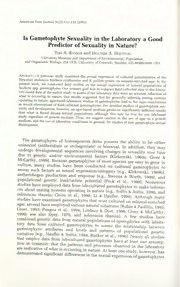
Is Gametophyte Sexuality in the Laboratory a Good Predictor of Sexuality in Nature? PDF
Preview Is Gametophyte Sexuality in the Laboratory a Good Predictor of Sexuality in Nature?
American Fern Journal 92(2):112-118 (2002) Gametophyte Good Is Sexuality Laboratory in the a Predictor of Sexuality Nature? in Tom Ranker and a. Heather Houston A. Museum University and Department of Environmental, Population, and Organismic Biology, 218 UCB, CO USA University of Colorado, Boulder, 80309-0350 A Abstract.— previous study examined the sexual expression of cultured gametophytes of the Hawaiian endemics Sadleha cyatheoides and grown pallida on S. mineral-enriched agar. In the we present work, conducted field studies on the sexual expression of natural populations of Sadleria spp. gametophytes. Our primary was goal compare to field-collected data to the labora- tory-based data of the study earlier to assess if the laboratory data were an accurate reflection of what occurring Our is in nature. results suggested that for generally inferring mating systems m operatmg nature, agar-based laboratory studies of gametophytes lead to the same conclusions would as observations of field-collected gametophytes. For detailed studies of gametophyte sex- and uality development, however, an medium agar-based produces significantly different results true study regardless of growth medium. we Thus, suggest caution in the use of agar growth as a medium, and the use of laboratory conditions in general, for studies of fern gametophyte sexual development. -^ The gametophytes homosporous of ferns possess the ability be to either unisexual [antheridiate or archegoniate] or bisexual. In may addition, they undergo developmental sequences involving changes in sexuality over time due to genetic and/or environmental factors (Klekowski, & 1969a; Greer McCarthy. Because 1999). gametophytes most of species are easy grow to in many culture, studies have been conducted on cultured gametophytes to assess such factors as sexual expression/ontogeny Klekowski, [e.g., 1969b), antheridiogen production and response Stevens & Werth (e.g., and 1999) populational genetic load/isolate potential [Peck 1990)' Numerous et al., studies have employed data from lab-cultured gametophytes make to inferen- ces about mating systems operating in nature & [e.g., Soltis 1990 and Soltis, references Chiou therein; & et al, 1998; Li Haulier, many Although 1999). studies have examined gametophytes were that cultured on mineral-enriched agar, several have employed various natural substrates (Rubin & Paolillo 1983- Greer. Pangua 1993; et 1994; Lindsay & al., Dyer, & 1996; Greer McCarthy! 1999; see also Dyer, and 1979, A references therein). few have studies combined genetic data from natural populations of sporophytes with labora- tory data from cultured gametophytes to assess the relationship between gametophytic and attributes and levels patterns of populational aenetic employ hat data from lab-cultured gametophytes have at least one assump- "'"""^^^^ °^^--d - thTLborZy P^°^^^^^^ rindicTrofwh are indicative whatr*'' of occurrmg is in nature. At one least study however has demonstrated significant differences in the sexual expression gametophytes o'f'
